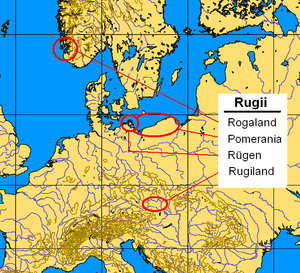
Back Руги Bulgarian Rugis Catalan Rugiové Czech Ругсем CV Rugiere Danish Rugier German Rugoj Esperanto Rugios Spanish Ruugit Finnish Ruges French

The Rugii, Rogi or Rugians (Ancient Greek: Ρογοί, romanized: Rogoi), were a Roman-era Germanic people.[1] They were first clearly recorded by Tacitus, in his Germania who called them the Rugii, and located them near the south shore of the Baltic Sea. Some centuries later, they were considered one of the "Gothic" or "Scythian" peoples who were located in the Middle Danube region. Like several other Gothic peoples there, they possibly arrived in the area as allies of Attila until his death in 453. They settled in what is now Lower Austria after the defeat of the Huns at Nedao in 454.
The Baltic Rugii mentioned by Tacitus are possibly related to the people known as the Rutikleioi, and the place known as Rougion, both mentioned in the second century by Ptolemy. Both these names are associated with the coastal island known today as Rügen. They have also been associated with the Ulmerugi mentioned in the sixth century by Jordanes, as people who had lived on the Baltic coast near the Vistula long before him. In a passage that is difficult to interpret Jordanes mentioned that the Rugii also lived in Scandinavia in his own time, near the Danes and Suedes.
It has been speculated, based on their name, and the Gothic origin stories published by Jordanes, that the Rugii originally migrated from southwest Norway to Pomerania around 100 AD, and from there to the Danube valley. The name of the Ulmerugi has been interpreted as Holmrygir known from much later Old Norse texts. The Rugii have also been associated with the Rygir of Rogaland in Norway. All these names apparently share their etymological origins.[2]
The name of the Rugii continued to be used after the sixth century to refer to Slavic speaking peoples including even Russians.[3]
- ^ Bjornlie, Shane (2018). "Rugians". In Nicholson, Oliver (ed.). The Oxford Dictionary of Late Antiquity. Oxford University Press. ISBN 9780191744457. Retrieved January 26, 2020.
Rugians. Germanic people prominent in provincial politics of the Danube frontier region during the last half of the 5th century...
- ^ Cite error: The named reference
Hoops452ffwas invoked but never defined (see the help page). - ^ Steinacher, Roland [in German] (2010). "The Herules: Fragments of a History". In Curta, Florin (ed.). Neglected Barbarians. ISD. ISBN 9782503531250. pp.43-44.
© MMXXIII Rich X Search. We shall prevail. All rights reserved. Rich X Search